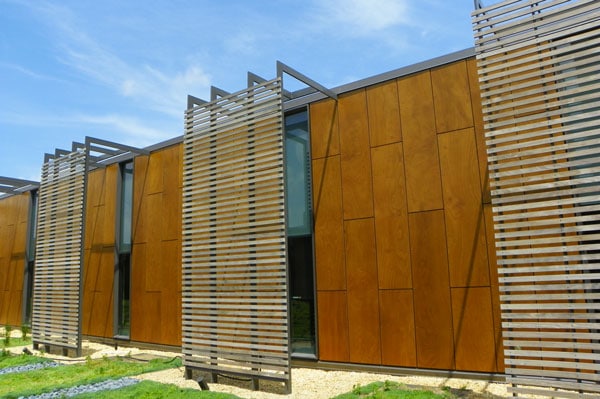Built of “locally-sourced” timber and stone, the twelve bed/one operating room Owensboro City Hospital accepted its first patient in 1899. In the century-plus that followed, the hospital became an organizing force in the health of the residents in and around Owensboro, Kentucky. Generations of residents were born, received life-long care, and watched following generations do the same at the hospital. More than a few updates were made, including a major rebuild in 1970, which also expanded the hospital’s reach into a regional facility. The structure served admirably for decades, but in the 2000s, it became clear that a new building was necessary to meet the changing needs of the population.
In designing a new hospital, the Owensboro Health Board of Directors found a suitable site nearby, but they faced a multitude of problems. Certain environmental issues were at play, including the presence of a flood plain and seismic zones. Top-of-mind for architect, HGA Architects and Engineers, was developing a space that relied on sustainable building practices to lessen the environmental impact of the structure, while creating an environment where the hospital itself was a part of the healing process. The plan was to design and build a structure where patients could receive exemplary care now, and hopefully, for another century into the future.
HGA Architects reached out to natural wood rainscreen manufacturer Prodema for a unique application for the hospital’s façade. According to Prodema, the Owensboro Health Regional Hospital rainscreen system consists of a “natural wood panel backed by a ventilated cavity that will expel moisture through air convection. The result is preventative care for “sick building disease,” which develops from moisture penetrating a building’s structure.
Many people are under the impression that wood materials are, by nature, environmentally irresponsible or require extensive maintenance. But Prodema shatters those notions and was selected for the Owensboro Health Regional Hospital for both the exceptional quality of their materials, and for the company’s commitment to sustainable manufacturing practices.
The rainscreens for the project were built using ProdEX, a high pressure laminate (HPL) panel that is considered a highly-durable decorative surface material. The ProdEx panels are chemical, fire, and wear resistant, and the thermos-setting process transforms resin into plastic, contributing to the exceptional durability. Prodema’s rainscreens are essentially maintenance-free, a rarity for natural wood building products.
Prodema was the first company in their sector to obtain ISO 14006 ECOdesign Certification on a worldwide basis, reflecting their company-wide focus on eco-friendly design. Prodema has taken great strides for lowering their environmental impact, including superior durability, use of recycled materials, and more efficient packaging. As a result, the use of Prodema’s materials can earn up to 16 points in the LEED certification grading system. The company releases Environmental Declarations (ECOlabels) for their products, making it easy for architects to weigh the impact of their designs.
While durability and sustainability were important to the designers and builders of Owensboro Health Regional Hospital, both efforts were in the service of superior patient care. The hospital’s overall plan was focused on the natural healing properties of the environment. Tall windows allow sunlight throughout the building, a rooftop garden sits atop the women’s services unit, and an outdoor walking trail winds throughout a property rich with trees and grassy areas.
Following this effort to create a holistic and healing environment throughout, Prodema’s natural wood was an easy choice for the building’s exterior. The rich wood blends seamlessly with the idyllic natural environment. Today, patients can take rejuvenating walks through the grounds and maintain that sense of well-being as they re-enter the hospital. Inside and out, Owensboro Health Regional Hospital was built following a proud tradition of patient care, and through foresight and innovation, represents the future of holistic, sustainable hospital design.

